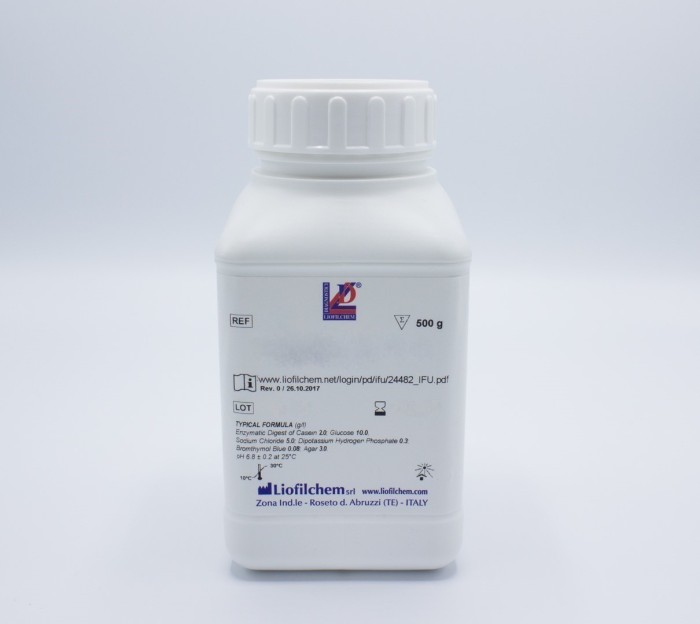Specifications:
| Application | Microbiology | ||
| Storage Temperature | Ambient | ||
| Product Type | Culture Medium | Forms | Powder |
| Product Brand | Liofilchem | ||
| Product Grade | Microbiology grade | ||
Desoxycholate Agar is a weakly selective medium designed for the isolation and differentiation of Enterobacteriaceae and other enteric Gram-negative bacteria from food, water, and environmental samples. It is not intended for diagnosing diseases or other human conditions but is crucial in microbiological quality control and research settings.
Key Features:
- Selectivity and Differentiation:
- Incorporates sodium desoxycholate and citrates as selective agents to inhibit Gram-positive organisms and other unwanted bacteria.
- Lactose fermentation is the primary differential characteristic, visible through colony coloration changes.
- Neutral red serves as a pH indicator to detect lactose fermentation.
- Applications:
- Primarily used for detecting lactose-fermenting bacteria (e.g., E. coli) and non-lactose fermenting bacteria (e.g., Salmonella spp. and Shigella spp.).
- Suitable for environmental, water, and food microbiological monitoring.
Medium Composition (per litre):
| Component | Amount (g/L) |
|---|---|
| Peptone | 10.0 |
| Lactose | 10.0 |
| Sodium Desoxycholate | 1.0 |
| Sodium Chloride | 5.0 |
| Potassium Phosphate | 2.0 |
| Ferric Citrate | 1.0 |
| Sodium Citrate | 1.0 |
| Neutral Red | 0.03 |
| Agar | 15.0 |
| Final pH: | 7.1 ± 0.2 |
Preparation:
- Dehydrated Medium:
- Suspend 45 g of powder in 1 litre of distilled or deionized water.
- Mix thoroughly and heat to boiling with frequent agitation until completely dissolved.
- Do not autoclave.
- Cool to 45-50°C before pouring into sterile Petri plates.
- Ready-to-use Medium in Bottles:
- Melt the bottle content in a water bath at 100°C (loosen the cap for ventilation).
- After complete dissolution, tighten the cap and check for homogeneity.
- Cool to 45-50°C, mix gently without foam formation, and pour aseptically into Petri dishes.
Test Procedure:
- Inoculation:
- Use streak/spread plating or pour plating methods.
- Employ environmental, water, or food samples.
- Incubation:
- Incubate plates aerobically at 35 ± 2°C for 18-24 hours.
- Result Interpretation:
- Lactose-fermenting bacteria: Red to pink colonies (e.g., E. coli).
- Non-lactose fermenting bacteria: Colourless colonies (e.g., Salmonella spp., Shigella spp.).
- Biochemical and immunological tests: Recommended for complete identification.
Quality Control:
- Appearance:
- Dehydrated Medium: Homogeneous, beige to pink-beige.
- Prepared Medium: Slightly opalescent, pink-red.
- Expected Cultural Response:
| Organism | Inoculum Size | Incubation | Characteristics |
|---|---|---|---|
| Escherichia coli ATCC 25922 | 50-100 CFU | 18-24 h / 35 ± 2°C | Good growth, red/pink colonies |
| Salmonella Typhimurium ATCC 14028 | 50-100 CFU | 18-24 h / 35 ± 2°C | Good growth, colourless colonies |
| Enterococcus faecalis ATCC 29212 | 103-104 CFU | 18-24 h / 35 ± 2°C | Inhibited |
| Staphylococcus aureus ATCC 25923 | 103-104 CFU | 18-24 h / 35 ± 2°C | Inhibited |
Storage and Stability:
- Dehydrated Medium:
- Store at 10-30°C in a dry environment, tightly sealed to prevent moisture absorption.
- Shelf life: 4 years.
- Prepared Medium:
- Store at 10-25°C in the dark to prevent light degradation.
- Shelf life: 6 months for plates and 2 years for bottled media.
Precautions:
- For professional use only.
- Follow biosafety protocols and wear appropriate PPE when handling potentially hazardous microorganisms.
- Do not use beyond the expiry date or if contamination/deterioration is evident.
Packaging Options:
| Format | Packaging | Ref. |
|---|---|---|
| Plate (90 mm) | 20 plates | 11027 |
| Bottle | 6 x 100 ml | 402340 |
| Bottle | 6 x 500 ml | 470030 |
| Dehydrated medium | 100 g | 620014 |
| Dehydrated medium | 500 g | 610014 |
| Dehydrated medium | 5 kg | 6100145 |
References:
- Farmer III, J. J. (2003). Enterobacteriaceae: introduction and identification. Manual of Clinical Microbiology.
- Leifson, E. (1935). New culture media based on sodium desoxycholate for the isolation of intestinal pathogens. J. Pathol. Bacteriol.
This comprehensive guide ensures optimal use of Desoxycholate Agar for selective isolation of enteric bacteria in microbiological investigations.
- Pack Size: 100g 500g 5kg




 0
0
